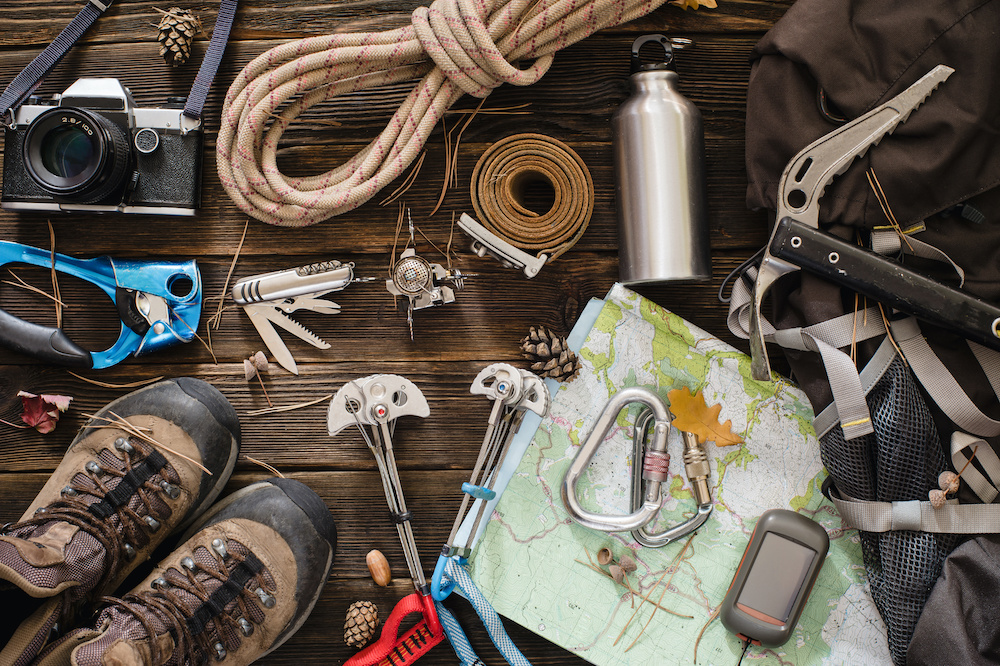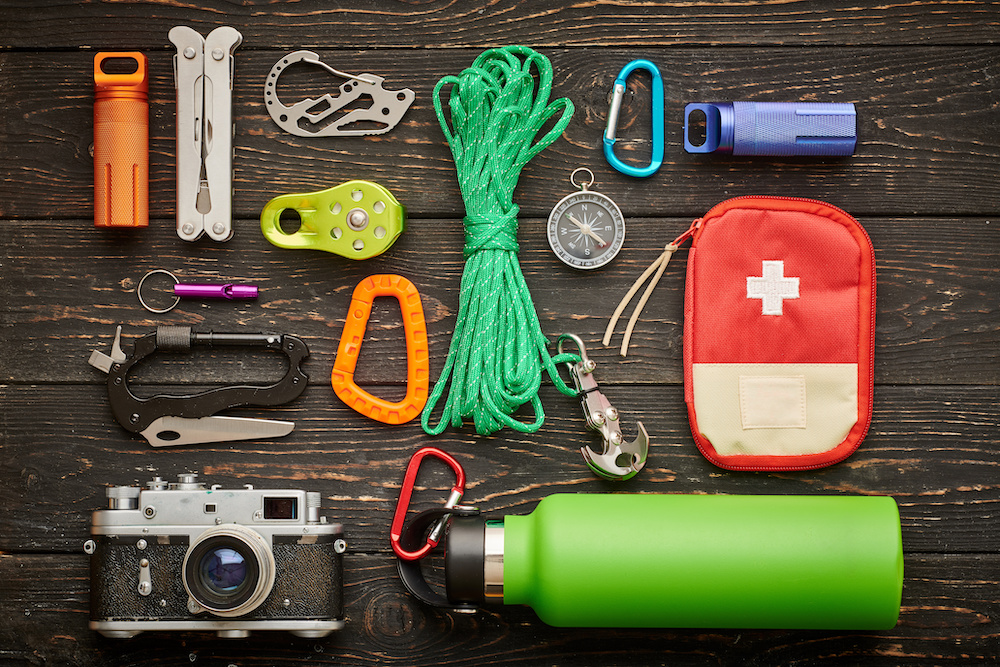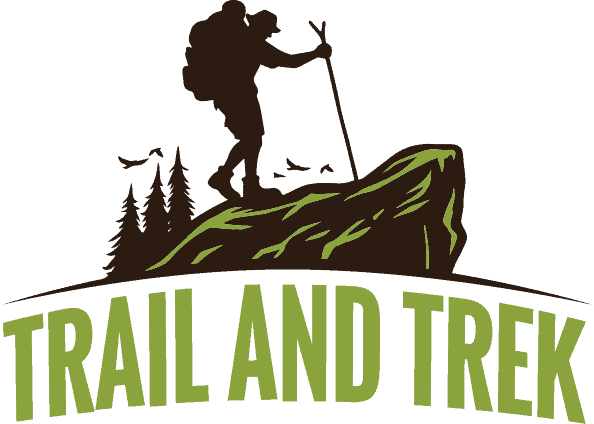
Hiking is a great way to relieve stress and keep you active after a week of working in the office.
However, hiking is not like a walk in the park because there are risks involved.
You need to be fully prepared before you go on a hike.
Thus, you must know the 10 essentials for hiking if you want to stay safe.
10 Essentials for Hiking
There is a lot to consider when answering the question, "What are the 10 essentials for hiking?"
With the many items you need to bring with you, we've divided our hiking equipment list into several categories.
1. Navigation Tools
You need traditional and modern tools to help you navigate through the area and keep you safe at all times.
The five essential navigation tools experts recommend because of their usefulness and reliability are:
- Map
As old school as a map maybe, you would need a traditional map of the area to know which parts of the place are safe for hikers.
It contains information about the specific area you plan to check out and the best route to take.
- Altimeter
This tool helps you determine the elevation of your location. This way, you can easily find streams, ridges, or known peaks.
- Compass
It is important to bring a compass with you when hiking since it allows you to find the right path.
Your compass will work hand-in-hand with the map of the area.
You just have to make sure that you know how to use and read it; otherwise, you'll get lost, defeating its main purpose.
- GPS Device
This modern safety device would indicate your exact location on a digital map.
Having it on hand will help rescuers find you easily and quickly if you got lost during the hike.
- PLBs (Personal Locator Beacons)
This device works hand-in-hand with your GPS device to help pick up your location so that someone will come to your help when needed.
- Mobile Phone
In this day and age, mobile phones have been one of the most important devices to have. That is even when you go hiking.
That's because you can use your mobile phone for navigation purposes.
It has GPS that you can switch on so that people can locate you easily.
If you're lucky, you can connect to a mobile data network to use the internet, allowing you to use digital maps or call for help via social media.
Of course, that is apart from allowing you to call or text anyone.
Most navigation devices on our list would require a battery or batteries for them to work.
As such, make sure you also have a fully charged power bank ready in case the battery dies.
2. Light Source
There are a lot of easy-t0-carry and user-friendly tools that can provide the light you need when hiking.
The most common ones that you can bring or choose from are:
- Headlamp
When you create a hiking checklist, headlamps should always be at the top.
This type of equipment will free your hands so you can do a lot of things with ease.
Even if the group wants to go back before dark, you still need to bring headlamps.
You have to remember that a lot of things can happen on the trail, and there is a chance that you will be delayed.
You need proper lighting in case it gets dark before you get back.
- Flashlight or Mobile Phone
If you don’t have a headlamp, there are other alternatives.
You can bring a flashlight or use your mobile phones as well.
3. Sun Protection
You need to protect your skin at all times, especially when hiking.
You will be exposed to the sun the whole time, so to prevent any skin problems, your hiking checklist should include any, most, or all of the following:
- Sunglasses
You need a pair of high-quality sunglasses that can filter about 99 percent of the ultraviolet rays from the sun.
If you are hiking during the winter, you need glacier glasses with a VLT rating ranging from five to 10 percent.
The lenses should be made from Trivex or polycarbonate. It should be scratch-resistant and a bit heavy.
That will make sure the sunglasses will stay protected while you are hiking.
- Sunscreen
You have to remember that the sun's UV rays can cause skin cancer and other health problems.
If you plan to hike more often, it is better to use sunscreen since you're more susceptible to these health issues.

What Should I Wear for Hiking Under the Sun?
Sun-protective clothes are the best choice for hiking since they can block the sun's UV rays, providing better protection than sunscreen.
As for footwear, make sure you wear the best hiking boots or shoes because they provide extra protection on the trail and offer more comfort and convenience.
You can wear regular footwear, but you should expect your feet to be swollen in just a few hours.
4. First Aid Kit
A first aid kit is one of the most important outdoor essentials because wounds are inevitable when hiking.
You will encounter many instances where you will get wounded in the different parts of your body.
Your first aid kit should be very compact and you should place the content in waterproof packaging.
It should have bandages, skin closures, roller bandages, gauze pads and dressings, antiseptic, tape, treatment supplies, blister prevention, non-prescription painkillers, and more.
5. Knife
Don’t be afraid to bring a knife; in fact, every member of the group should have one.
You are not bringing it for self-defense since you can also use it for other things, such as first aid, emergency, repair, food preparation, and climbing.
Sharpen the knives before you go on a trip, and don’t bring too much. One or two knives will do.
It is better to bring a smaller knife or get a chef’s knife since it is more versatile and you can use it for a wide variety of tasks.
6. Firestarter
Whether you are staying the night or plan to go back before dark, you need to bring a firestarter
such as a butane lighter or matches.
You can use fire for cooking food and keep you warm. It will also provide extra protection if you are going to camp at night.
Make sure that you use these fire starters wisely because you might accidentally burn the area.
You have to kill the fire as soon as you are done using it.
7. Shelter
Always bring a shelter with you when hiking. Many unforeseen events can happen during your hike, and you don’t want to be unprepared for these accidents.
The shelter will protect you against the wind and rain and prevent insects from biting you while you're sleeping.
You can bring space blankets, a sleeping pad, or a small tent with you if you don’t mind the extra weight.
8. Food
Food is one of the most important outdoor essentials because you won’t have energy without it.
Bringing chocolates is indeed an excellent way to boost your energy levels, but you can’t rely on them during the trip.
You need to bring food that would give you the energy you need to complete the hike.
It is also better to bring easily digestible food that requires no cooking and you can store for a long time.
If you can bring a stove with you, you can pack other ingredients and cook your food.
You can look for backpacking stoves that are very easy to carry.
It is a good idea if you plan to stay for a couple of days on the trail.
9. Extra Water
You should always carry enough water for your hike.
If you chose a popular hiking area, it is easier to find a source of clean water.
You can bring refillable water bottles so you can refill them when you reach these areas.
You can also get a backpack with a hydration pocket, which is easier to carry since it is already attached to the bag.
You can also drink your water even without opening the daypack because a straw-like tube is connected to the hydration pocket.
You should know that the amount of water that you will drink depends on the weather.
If it is too hot, you should already expect that your body will ask for water constantly.
10. Extra Clothes
Bringing extra clothes is a safety precaution, especially if you need to stay in the hiking area during the night.
You can’t wear your clothes for several days.
The clothes you are wearing are probably drenched in sweat and won’t smell good if you use them until the next day.
You should always expect the unexpected and bring extra clothes with you.
Accidents and emergencies are very common during hikes, so you need to be prepared.
What Should I Bring to Backcountry Hiking: The Conclusion
There are a lot of unknowns during a hike so you should always be prepared for all the circumstances that can happen.
With our hiking equipment list, you should pay extra attention to the safety gear.
They are the most important equipment that you need to bring with you at all times.
